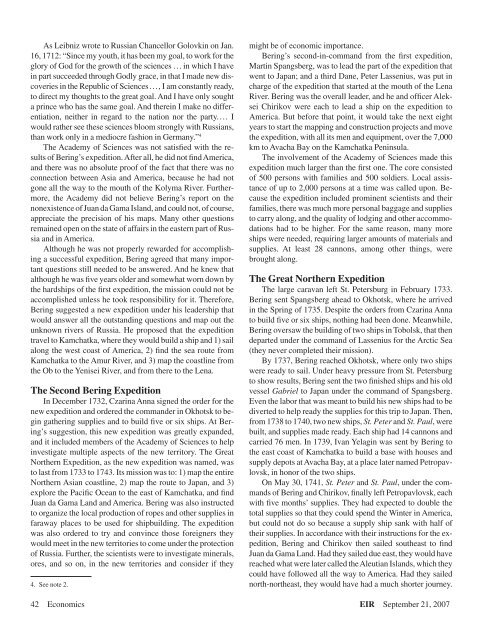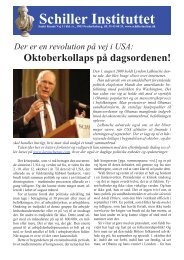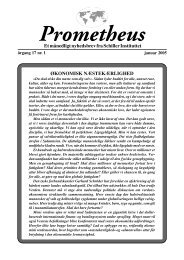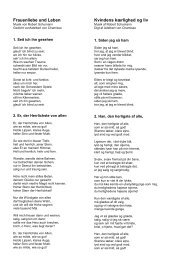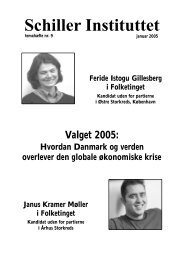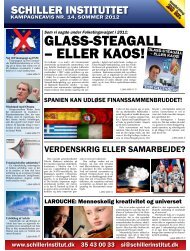Vitus Bering and the Rediscovery of America - schillerinstitut.dk
Vitus Bering and the Rediscovery of America - schillerinstitut.dk
Vitus Bering and the Rediscovery of America - schillerinstitut.dk
Create successful ePaper yourself
Turn your PDF publications into a flip-book with our unique Google optimized e-Paper software.
As Leibniz wrote to Russian Chancellor Golovkin on Jan.<br />
16, 1712: “Since my youth, it has been my goal, to work for <strong>the</strong><br />
glory <strong>of</strong> God for <strong>the</strong> growth <strong>of</strong> <strong>the</strong> sciences . . . in which I have<br />
in part succeeded through Godly grace, in that I made new discoveries<br />
in <strong>the</strong> Republic <strong>of</strong> Sciences . . . , I am constantly ready,<br />
to direct my thoughts to <strong>the</strong> great goal. And I have only sought<br />
a prince who has <strong>the</strong> same goal. And <strong>the</strong>rein I make no differentiation,<br />
nei<strong>the</strong>r in regard to <strong>the</strong> nation nor <strong>the</strong> party. . . . I<br />
would ra<strong>the</strong>r see <strong>the</strong>se sciences bloom strongly with Russians,<br />
than work only in a mediocre fashion in Germany.” <br />
The Academy <strong>of</strong> Sciences was not satisfied with <strong>the</strong> results<br />
<strong>of</strong> <strong>Bering</strong>’s expedition. After all, he did not find <strong>America</strong>,<br />
<strong>and</strong> <strong>the</strong>re was no absolute pro<strong>of</strong> <strong>of</strong> <strong>the</strong> fact that <strong>the</strong>re was no<br />
connection between Asia <strong>and</strong> <strong>America</strong>, because he had not<br />
gone all <strong>the</strong> way to <strong>the</strong> mouth <strong>of</strong> <strong>the</strong> Kolyma River. Fur<strong>the</strong>rmore,<br />
<strong>the</strong> Academy did not believe <strong>Bering</strong>’s report on <strong>the</strong><br />
nonexistence <strong>of</strong> Juan da Gama Isl<strong>and</strong>, <strong>and</strong> could not, <strong>of</strong> course,<br />
appreciate <strong>the</strong> precision <strong>of</strong> his maps. Many o<strong>the</strong>r questions<br />
remained open on <strong>the</strong> state <strong>of</strong> affairs in <strong>the</strong> eastern part <strong>of</strong> Russia<br />
<strong>and</strong> in <strong>America</strong>.<br />
Although he was not properly rewarded for accomplishing<br />
a successful expedition, <strong>Bering</strong> agreed that many important<br />
questions still needed to be answered. And he knew that<br />
although he was five years older <strong>and</strong> somewhat worn down by<br />
<strong>the</strong> hardships <strong>of</strong> <strong>the</strong> first expedition, <strong>the</strong> mission could not be<br />
accomplished unless he took responsibility for it. Therefore,<br />
<strong>Bering</strong> suggested a new expedition under his leadership that<br />
would answer all <strong>the</strong> outst<strong>and</strong>ing questions <strong>and</strong> map out <strong>the</strong><br />
unknown rivers <strong>of</strong> Russia. He proposed that <strong>the</strong> expedition<br />
travel to Kamchatka, where <strong>the</strong>y would build a ship <strong>and</strong> 1) sail<br />
along <strong>the</strong> west coast <strong>of</strong> <strong>America</strong>, 2) find <strong>the</strong> sea route from<br />
Kamchatka to <strong>the</strong> Amur River, <strong>and</strong> 3) map <strong>the</strong> coastline from<br />
<strong>the</strong> Ob to <strong>the</strong> Yenisei River, <strong>and</strong> from <strong>the</strong>re to <strong>the</strong> Lena.<br />
The Second <strong>Bering</strong> Expedition<br />
In December 1732, Czarina Anna signed <strong>the</strong> order for <strong>the</strong><br />
new expedition <strong>and</strong> ordered <strong>the</strong> comm<strong>and</strong>er in Okhotsk to begin<br />
ga<strong>the</strong>ring supplies <strong>and</strong> to build five or six ships. At <strong>Bering</strong>’s<br />
suggestion, this new expedition was greatly exp<strong>and</strong>ed,<br />
<strong>and</strong> it included members <strong>of</strong> <strong>the</strong> Academy <strong>of</strong> Sciences to help<br />
investigate multiple aspects <strong>of</strong> <strong>the</strong> new territory. The Great<br />
Nor<strong>the</strong>rn Expedition, as <strong>the</strong> new expedition was named, was<br />
to last from 1733 to 1743. Its mission was to: 1) map <strong>the</strong> entire<br />
Nor<strong>the</strong>rn Asian coastline, 2) map <strong>the</strong> route to Japan, <strong>and</strong> 3)<br />
explore <strong>the</strong> Pacific Ocean to <strong>the</strong> east <strong>of</strong> Kamchatka, <strong>and</strong> find<br />
Juan da Gama L<strong>and</strong> <strong>and</strong> <strong>America</strong>. <strong>Bering</strong> was also instructed<br />
to organize <strong>the</strong> local production <strong>of</strong> ropes <strong>and</strong> o<strong>the</strong>r supplies in<br />
faraway places to be used for shipbuilding. The expedition<br />
was also ordered to try <strong>and</strong> convince those foreigners <strong>the</strong>y<br />
would meet in <strong>the</strong> new territories to come under <strong>the</strong> protection<br />
<strong>of</strong> Russia. Fur<strong>the</strong>r, <strong>the</strong> scientists were to investigate minerals,<br />
ores, <strong>and</strong> so on, in <strong>the</strong> new territories <strong>and</strong> consider if <strong>the</strong>y<br />
. See note 2.<br />
might be <strong>of</strong> economic importance.<br />
<strong>Bering</strong>’s second-in-comm<strong>and</strong> from <strong>the</strong> first expedition,<br />
Martin Spangsberg, was to lead <strong>the</strong> part <strong>of</strong> <strong>the</strong> expedition that<br />
went to Japan; <strong>and</strong> a third Dane, Peter Lassenius, was put in<br />
charge <strong>of</strong> <strong>the</strong> expedition that started at <strong>the</strong> mouth <strong>of</strong> <strong>the</strong> Lena<br />
River. <strong>Bering</strong> was <strong>the</strong> overall leader, <strong>and</strong> he <strong>and</strong> <strong>of</strong>ficer Aleksei<br />
Chirikov were each to lead a ship on <strong>the</strong> expedition to<br />
<strong>America</strong>. But before that point, it would take <strong>the</strong> next eight<br />
years to start <strong>the</strong> mapping <strong>and</strong> construction projects <strong>and</strong> move<br />
<strong>the</strong> expedition, with all its men <strong>and</strong> equipment, over <strong>the</strong> 7,000<br />
km to Avacha Bay on <strong>the</strong> Kamchatka Peninsula.<br />
The involvement <strong>of</strong> <strong>the</strong> Academy <strong>of</strong> Sciences made this<br />
expedition much larger than <strong>the</strong> first one. The core consisted<br />
<strong>of</strong> 500 persons with families <strong>and</strong> 500 soldiers. Local assistance<br />
<strong>of</strong> up to 2,000 persons at a time was called upon. Because<br />
<strong>the</strong> expedition included prominent scientists <strong>and</strong> <strong>the</strong>ir<br />
families, <strong>the</strong>re was much more personal baggage <strong>and</strong> supplies<br />
to carry along, <strong>and</strong> <strong>the</strong> quality <strong>of</strong> lodging <strong>and</strong> o<strong>the</strong>r accommodations<br />
had to be higher. For <strong>the</strong> same reason, many more<br />
ships were needed, requiring larger amounts <strong>of</strong> materials <strong>and</strong><br />
supplies. At least 28 cannons, among o<strong>the</strong>r things, were<br />
brought along.<br />
The Great Nor<strong>the</strong>rn Expedition<br />
The large caravan left St. Petersburg in February 1733.<br />
<strong>Bering</strong> sent Spangsberg ahead to Okhotsk, where he arrived<br />
in <strong>the</strong> Spring <strong>of</strong> 1735. Despite <strong>the</strong> orders from Czarina Anna<br />
to build five or six ships, nothing had been done. Meanwhile,<br />
<strong>Bering</strong> oversaw <strong>the</strong> building <strong>of</strong> two ships in Tobolsk, that <strong>the</strong>n<br />
departed under <strong>the</strong> comm<strong>and</strong> <strong>of</strong> Lassenius for <strong>the</strong> Arctic Sea<br />
(<strong>the</strong>y never completed <strong>the</strong>ir mission).<br />
By 1737, <strong>Bering</strong> reached Okhotsk, where only two ships<br />
were ready to sail. Under heavy pressure from St. Petersburg<br />
to show results, <strong>Bering</strong> sent <strong>the</strong> two finished ships <strong>and</strong> his old<br />
vessel Gabriel to Japan under <strong>the</strong> comm<strong>and</strong> <strong>of</strong> Spangsberg.<br />
Even <strong>the</strong> labor that was meant to build his new ships had to be<br />
diverted to help ready <strong>the</strong> supplies for this trip to Japan. Then,<br />
from 1738 to 1740, two new ships, St. Peter <strong>and</strong> St. Paul, were<br />
built, <strong>and</strong> supplies made ready. Each ship had 14 cannons <strong>and</strong><br />
carried 76 men. In 1739, Ivan Yelagin was sent by <strong>Bering</strong> to<br />
<strong>the</strong> east coast <strong>of</strong> Kamchatka to build a base with houses <strong>and</strong><br />
supply depots at Avacha Bay, at a place later named Petropavlovsk,<br />
in honor <strong>of</strong> <strong>the</strong> two ships.<br />
On May 30, 1741, St. Peter <strong>and</strong> St. Paul, under <strong>the</strong> comm<strong>and</strong>s<br />
<strong>of</strong> <strong>Bering</strong> <strong>and</strong> Chirikov, finally left Petropavlovsk, each<br />
with five months’ supplies. They had expected to double <strong>the</strong><br />
total supplies so that <strong>the</strong>y could spend <strong>the</strong> Winter in <strong>America</strong>,<br />
but could not do so because a supply ship sank with half <strong>of</strong><br />
<strong>the</strong>ir supplies. In accordance with <strong>the</strong>ir instructions for <strong>the</strong> expedition,<br />
<strong>Bering</strong> <strong>and</strong> Chirikov <strong>the</strong>n sailed sou<strong>the</strong>ast to find<br />
Juan da Gama L<strong>and</strong>. Had <strong>the</strong>y sailed due east, <strong>the</strong>y would have<br />
reached what were later called <strong>the</strong> Aleutian Isl<strong>and</strong>s, which <strong>the</strong>y<br />
could have followed all <strong>the</strong> way to <strong>America</strong>. Had <strong>the</strong>y sailed<br />
north-nor<strong>the</strong>ast, <strong>the</strong>y would have had a much shorter journey.<br />
42 Economics EIR September 21, 2007


